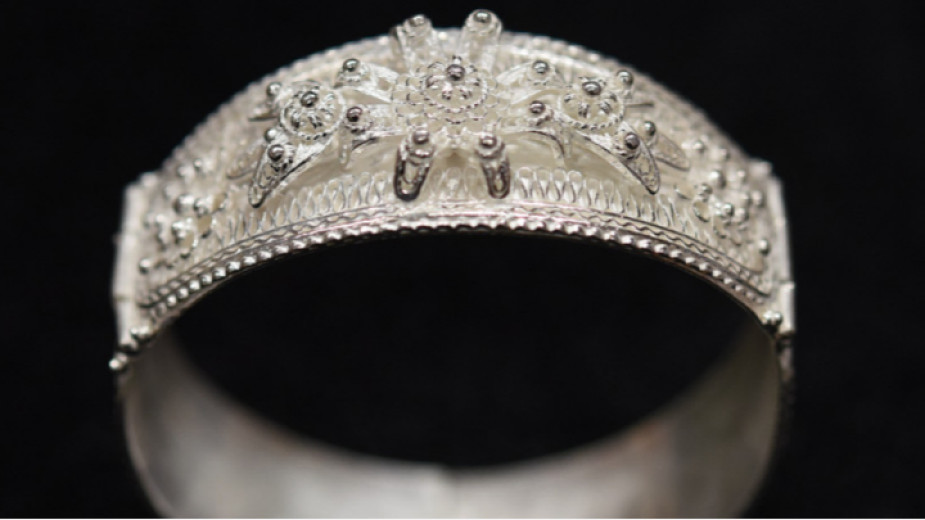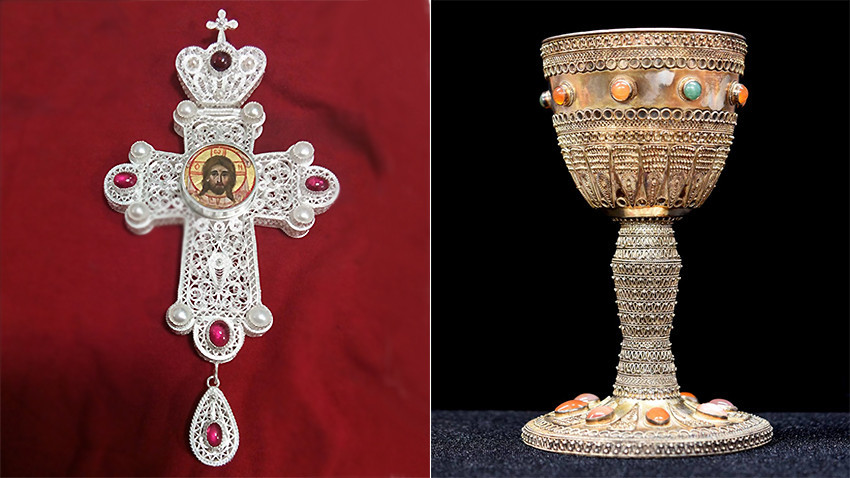 13
13
To become a real master craftsman one needs talent, dedication and a lot of time. Nowadays, when society lives quick and easy life, a series of Bulgarian crafts are about to disappear. There are simply no master craftsmen left. One of these crafts is jewelry making and more specifically the fine technique- filigree. The name itself is derived from the Latin words for thread (filum) and grain (granum), with the latter referring to the tiny beads that were often used in filigree jewelry. One of the most fascinating jewelry-making techniques still in use today, involves twisting thin metal threads into intricate lace-line patterns. The fine wire pieces are then soldered together to create a larger piece. Filigree is used in making jewelry, earrings, necklaces, mugs, trays, belts, frames, etc.

This technique requires a high level of artistic and jewelry-making skills. The entire process is extremely difficult, master jeweler Tsetsa Damyanova from the town of Berkovitsa said for the BNR. In her words, the technique dates back to ancient times and appeared on the territory of present-day Bulgaria around 3,000 BC. In the Middle Ages, filigree was a highly developed craft- master jewelers had a flair for detail. That is why their works were part of the church utensils. Later, citizens wore this type of jewelry as a sign of a social status. Some of the most exquisite and expensive pieces of jewelry in Bulgaria were made of pure silver and gold coating. They are the work of the master jewelers from the Chiprovtsi School. After the National Revival period, they gained popularity across Europe.

“This jewelry-making technique is extremely difficult and takes years of training to reach the necessary level to create a beautiful jewel with its own distinction”, Tsetsa Damyanova said for the BNR.
She herself began practicing this technique more than 60 years ago. She was part of the cooperative “Souvenirs and Jewelry in Berkovitsa” which was established in the 1960’s by Teodor Spassov from the Chiprovtsi School. Today, ten jewelers are members of this cooperative society. However, young people are not showing enough interest in this art.
In fact, Nikola Vaptsarov School in Plovdiv is the only Bulgarian school that offers special training in jewelry-making. For nearly two decades, hundreds of Bulgarian students have had the opportunity to gain knowledge and learn the subtleties of this beautiful craft.

Recently, the alumni studying jewelry-making had the unique opportunity to study filigree thanks to the assistance of the few remaining master jewelers Stefan Stefchev, Albena Stefcheva and Tsetsa Damyanova.

“I was very happy to learn that a class in Plovdiv offers training in jewelry making under the project. This is great. These are young people who show interest in filigree and give this technique a modern look. Their works are very beautiful. That is why we must support these children”, Tsveta Damyanova said.
The master jewelers were impressed by the enthusiasm and diligence of the young people who used the filigree technique to make earrings and silver pendants.
If you are also interested in ancient Bulgarian crafts, you can visit the traditional Crafts Week in Plovdiv. This year it will be held between June 27 and July 3 at the Regional Ethnographic Museum in Bulgaria’s second biggest city.

Compiled by: Vesela Krasteva (interview by Lili Goleminova, BNR-Radio Sofia)
English version: Kostadin Atanasov
Photos: filigree.bg, Facebook / @Filigree.bg, ruralbalkans.comFor the twenty-third year, the Bansko Film Fest team will take the audience to some of the most extreme corners of the world with 75 films from 39 countries . ''All of them are premieres, and for some of them, the screenings in Bansko will be..
The 38th edition of the Cinemania (Kinomania) Film Festival will kick off in Hall 1 of the National Palace of Culture in Sofia tonight, November 13. The cinematic panorama opens with the newest feature film by director Milko Lazarov, Tarika ,..
The 38th edition of Cinemania ( Kinomania ) starts in Hall 1 of the National Palace of Culture in Sofia. The festival opens on November 13 with a premiere of the film "Tarika". After its successes around the world and the completely..
The fourth national Biennial of Illustrations opens today in the triangular tower of Serdica, part of the Regional Museum of History in Sofia. As..

+359 2 9336 661
